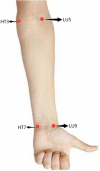Specificity for the correlation between the body surface and viscera in the pathological state of COPD: A prospective, controlled, and assessor-blinded trial
- PMID: 37153229
- PMCID: PMC10159081
- DOI: 10.3389/fphys.2023.1051190
Specificity for the correlation between the body surface and viscera in the pathological state of COPD: A prospective, controlled, and assessor-blinded trial
Abstract
Background: The association between the body surface and viscera remains obscure, but a better understanding of the body surface-viscera correlation will maximize its diagnostic and therapeutic values in clinical practice. Therefore, this study aimed to investigate the specificity of body surface-viscera correlation in the pathological state. Methods: The study subjects included 40 participants with chronic obstructive pulmonary disease (COPD) in the COPD group and 40 age-matched healthy participants in the healthy control group. Laser Doppler flowmetry, infrared thermography, and functional near-infrared spectroscopy were respectively adopted to measure 1) the perfusion unit (PU), 2) temperature, and 3) regional oxygen saturation (rSO2) of four specific sites distributed in the heart and lung meridians. These three outcome measures reflected the microcirculatory, thermal, and metabolic characteristics, respectively. Results: Regarding the microcirculatory and thermal characteristics of the body surface, the PU and temperature of specific sites on the body surface [i.e., Taiyuan (LU9) and Chize (LU5) in the lung meridian] in the COPD group were significantly increased compared with healthy controls (p < 0.05), whereas PU and temperature of other sites in the heart meridian [i.e., Shenmen (HT7) and Shaohai (HT3)] did not change significantly (p > 0.05). Regarding the metabolic characteristics, rSO2 of specific sites in the lung meridian [i.e., Taiyuan (LU9) and Chize (LU5)] and Shaohai (HT3) of the heart meridian in the COPD group was significantly decreased compared with healthy controls (p < 0.01), whereas rSO2 of Shenmen (HT7) in the heart meridian did not change significantly (p > 0.05). Conclusion: In the disease state of COPD, the microcirculatory, thermal, and metabolic characteristics of specific sites on the body surface in the lung meridian generally manifest more significant changes than those in the heart meridian, thereby supporting relative specificity for the body surface-viscera correlation in the pathological state.
Keywords: acupuncture; comparative study; infrared thermography; site specificity; skin physiology.
Copyright © 2023 Jiang, Hu, He, Li, Zhang, Lou, Wu, Fang, Shao and Fang.
Conflict of interest statement
The authors declare that the research was conducted in the absence of any commercial or financial relationships that could be construed as a potential conflict of interest.
Figures







Similar articles
-
The Moxibustion-Induced Thermal Transport Effect Between the Heart and Lung Meridians With Infrared Thermography.Front Cardiovasc Med. 2022 May 13;9:817901. doi: 10.3389/fcvm.2022.817901. eCollection 2022. Front Cardiovasc Med. 2022. PMID: 35647050 Free PMC article.
-
Difference in Moxibustion-Induced Microcirculatory Responses between the Heart and Lung Meridians Assessed by Laser Doppler Flowmetry.Evid Based Complement Alternat Med. 2021 Apr 1;2021:6644625. doi: 10.1155/2021/6644625. eCollection 2021. Evid Based Complement Alternat Med. 2021. PMID: 33868440 Free PMC article.
-
The difference in heat transport characteristics of the heart and lung meridians: A comparative study of COPD patients and healthy subjects.Medicine (Baltimore). 2021 Feb 5;100(5):e23804. doi: 10.1097/MD.0000000000023804. Medicine (Baltimore). 2021. PMID: 33592838 Free PMC article. Clinical Trial.
-
Mechanism of acupuncture regulating visceral sensation and mobility.Front Med. 2011 Jun;5(2):151-6. doi: 10.1007/s11684-011-0129-7. Epub 2011 Jun 22. Front Med. 2011. PMID: 21695619 Review.
-
[Advances and trends in the researches on meridians].Sheng Wu Yi Xue Gong Cheng Xue Za Zhi. 2008 Dec;25(6):1470-3, 1478. Sheng Wu Yi Xue Gong Cheng Xue Za Zhi. 2008. PMID: 19166234 Review. Chinese.
References
-
- Álvarez-Prats D., Carvajal-Fernández O., Valera Garrido F., Pecos-Martín D., García-Godino A., Santafe M. M., et al. (2019). Acupuncture points and perforating cutaneous vessels identified using infrared thermography: A cross-sectional pilot study. Evid. Based Complement. Altern. Med. 2019, 7126439. 10.1155/2019/7126439 - DOI - PMC - PubMed
-
- Buekers J., Theunis J., De Boever P., Vaes A. W., Koopman M., Janssen E. V., et al. (2019). Wearable finger pulse oximetry for continuous oxygen saturation measurements during daily home routines of patients with chronic obstructive pulmonary disease (COPD) over one week: Observational study. Obs. Study 7 (6), e12866. 10.2196/12866 - DOI - PMC - PubMed
-
- Buekers J., Theunis J., De Boever P., Vaes A. W., Koopman M., Janssen E. V., et al. (2019). Wearable finger pulse oximetry for continuous oxygen saturation measurements during daily home routines of patients with chronic obstructive pulmonary disease (COPD) over one week: Observational study. JMIR Mhealth Uhealth 7 (6), e12866. 10.2196/12866 - DOI - PMC - PubMed
LinkOut - more resources
Full Text Sources

